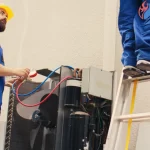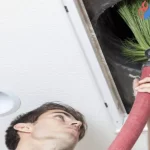Can I service my AC myself?
Air conditioners, also known as ACs, are crucial for keeping your home or office cool and comfortable during hot and humid weather conditions. However, like all appliances, ACs require maintenance and servicing to ensure that they function optimally and last for a long time. The question that many homeowners and office managers have is whether they can service their ACs themselves or whether they need to hire a professional technician. In this article, we’ll explore this question in detail and provide guidance on when it is appropriate to service your AC yourself.
Understanding the components of an AC
Before we discuss whether or not you can service your AC yourself, it is essential to understand the components of an AC. An air conditioner typically consists of an indoor unit that contains the evaporator coil, an outdoor unit that contains the condenser coil, a compressor, a fan, and a refrigerant. The evaporator coil cools the air inside your home or office, while the condenser coil releases the heat outside. The compressor compresses the refrigerant, and the fan circulates the air. The refrigerant is the fluid that removes heat from the air and cools it down.
Can you service your AC yourself?
The answer to this question depends on several factors. Some AC maintenance tasks are relatively simple and can be done by homeowners or office managers with some basic tools and knowledge of the system. Other tasks are more complex and require specialized tools and knowledge that only a professional AC technician possesses.
Changing air filters
One of the most important AC maintenance tasks is changing the air filter. The air filter traps dust, dirt, and other particles from the air, preventing them from clogging the evaporator coil and reducing the AC’s efficiency. Changing the air filter is a simple task that most homeowners or office managers can do without professional help. All you need to do is locate the air filter, remove it, and replace it with a new one. The frequency of changing the air filter depends on the AC’s usage and the air quality in your area. Typically, you should change the air filter every one to three months.
Cleaning the outdoor unit
The outdoor unit of the AC contains the condenser coil, which releases heat outside. Over time, dust, leaves, and other debris can accumulate on the condenser coil, reducing its efficiency. Cleaning the outdoor unit is another task that most homeowners or office managers can do without professional help. To clean the outdoor unit, you will need to turn off the power supply to the AC, remove the fan, and then use a hose to wash the condenser coil. Make sure that the water pressure is not too high, as it can damage the delicate fins on the coil.
Checking the refrigerant levels
The refrigerant is the fluid that removes heat from the air and cools it down. If the refrigerant level is too low, the AC will not function optimally, and you may notice that the air is not as cool as it should be. Checking the refrigerant level is a more complex task that requires specialized tools and knowledge. If you are not familiar with how to check the refrigerant level, it is best to hire a professional AC technician to do it for you.
Checking the electrical connections
The electrical connections in the AC ensure that all the components are working together correctly. Over time, these connections can become loose or damaged, leading to the malfunctioning of the system. Checking the electrical connections is a task that requires specialized knowledge and tools. If you are not familiar with how to check the electrical connections, it is best to hire a professional AC technician to do it for you.
Cleaning the evaporator coil
The evaporator coil cools the air inside your home or office. Over time, dust, dirt, and other particles can accumulate on the evaporator coil, reducing its efficiency. Cleaning the evaporator coil is a task that requires specialized knowledge and tools. You will need to remove the cover of the indoor unit, locate the evaporator coil, and then use a soft brush or vacuum cleaner to remove any debris. If you are not familiar with how to clean the evaporator coil, it is best to hire a professional AC technician to do it for you.
Lubricating the fan motor
The fan motor in the AC circulates the air. Over time, the fan motor can become dry, leading to increased friction and reduced efficiency. Lubricating the fan motor is a task that requires specialized knowledge and tools. If you are not familiar with how to lubricate the fan motor, it is best to hire a professional AC technician to do it for you.
Inspecting the ductwork
The ductwork in your home or office delivers the cooled air from the AC to the various rooms. Over time, the ductwork can become clogged with dust and debris, reducing the airflow and efficiency of the AC. Inspecting the ductwork is a task that requires specialized tools and knowledge. If you are not familiar with how to inspect the ductwork, it is best to hire a professional AC technician to do it for you.
When to hire a professional AC technician
While some AC maintenance tasks can be done by homeowners or office managers, others require specialized knowledge and tools. It is always best to hire a professional AC technician for tasks such as checking the refrigerant level, checking the electrical connections, cleaning the evaporator coil, lubricating the fan motor, and inspecting the ductwork.
When it comes to servicing your AC, it is important to prioritize the safety and optimal functioning of your AC system. That is why it is recommended to hire a professional AC technician, such as Al Hadi AC Repair & Maintenance Services, for tasks that require specialized knowledge and tools.
Al Hadi AC Repair & Maintenance Services offers a wide range of AC maintenance and repair services to help ensure that your AC system is functioning at its best. Some of the services they offer include checking the refrigerant level, checking the electrical connections, cleaning the evaporator coil, lubricating the fan motor, and inspecting the ductwork.




